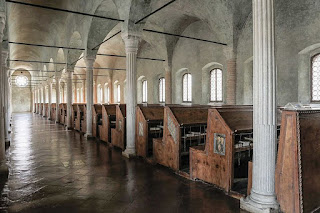Alberto Marvelli - Rimini's Good Samaritan
Heroic deeds helped victims of bombing raids
Alberto Marvelli, who came to be seen as a modern day Good Samaritan after risking his life repeatedly to help the victims of devastating air raids in the Second World War, was born on this day in 1918 in Ferrara. He died in 1946 at the age of only 28 when he was hit by a truck while riding his bicycle but in his short life identified himself to many as a true hero. Marvelli's acts of heroism occurred mainly in Rimini, his adopted home town, which suffered heavy bombing from the Allies due to its proximity to the German defensive fortifications known as the Gothic or Green Line. As well as giving aid and comfort to the wounded and dying and to those whose homes and possessions had been destroyed, Marvelli also rescued many Rimini citizens from trains destined for concentration camps. He was beatified by Pope John Paul II in 2004. Read more…
_________________________________________________________________
Benedetta Cambiagio Frassinello – Educator
Nun who promoted the rights of girls to a quality education
The Feast Day of Saint Benedetta Cambiagio Frassinello, who founded the Benedictine Sisters of Providence, is celebrated on this day, the anniversary of her death in 1858. Benedetta carried out pioneering work by rescuing poor and abandoned girls and promoting their rights to a good education. She was made a saint by Pope John Paul II in 2002. Benedetta was born in 1791 in Genoa but her family later moved to Pavia. She dedicated herself to the education of young girls who had been abandoned or who were at risk in the area, eventually opening a school. She later founded the Congregation of the Benedictine Sisters of Providence, which concentrated on the education of young girls. Read more...
_________________________________________________________________
Angela Merici – Saint
Nun dedicated her life to educating girls
Angela Merici, who founded the monastic Ursuline Order, was born on this day in 1474 in Desenzano del Garda. The Ursulines are the oldest order of women in the Roman Catholic Church dedicated to teaching and were the first to work outside a convent in the community. Merici became deeply religious after she was orphaned at 15. It is claimed she became suddenly blind on the island of Crete on her way to the Holy Land but was cured of her blindness on her return, while praying at exactly the same place. where she had been afflicted. Merici and 28 of her followers formed the Company of St Ursula, named after a fourth century martyr, in 1535. Their idea was to provide for the Christian education of girls in order to restore the family and, through the family, the whole of Christian society. Merici was beatified in 1768 and canonised in 1807. Read more…
Home











